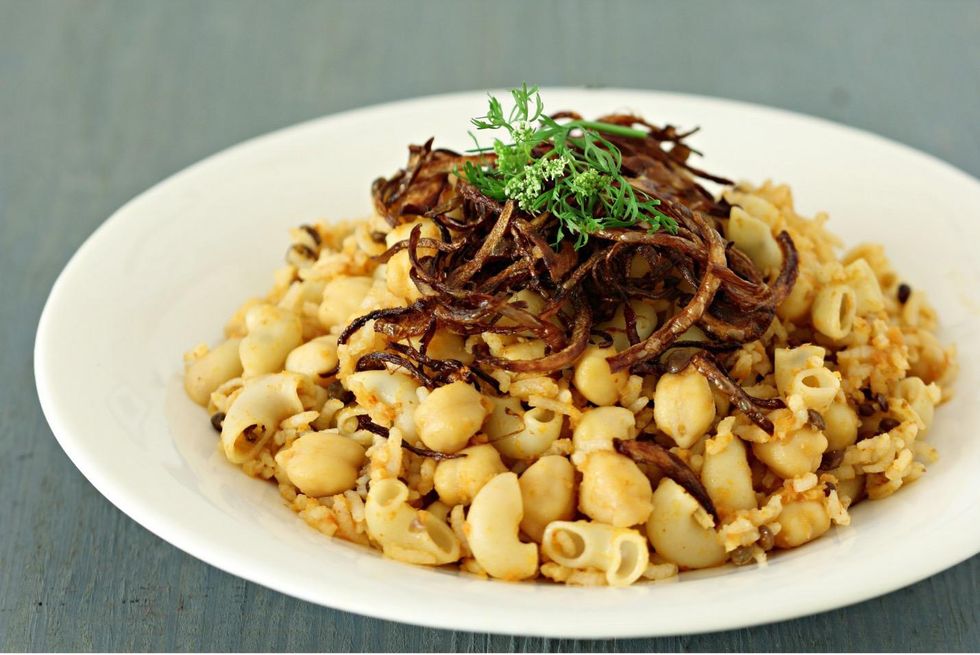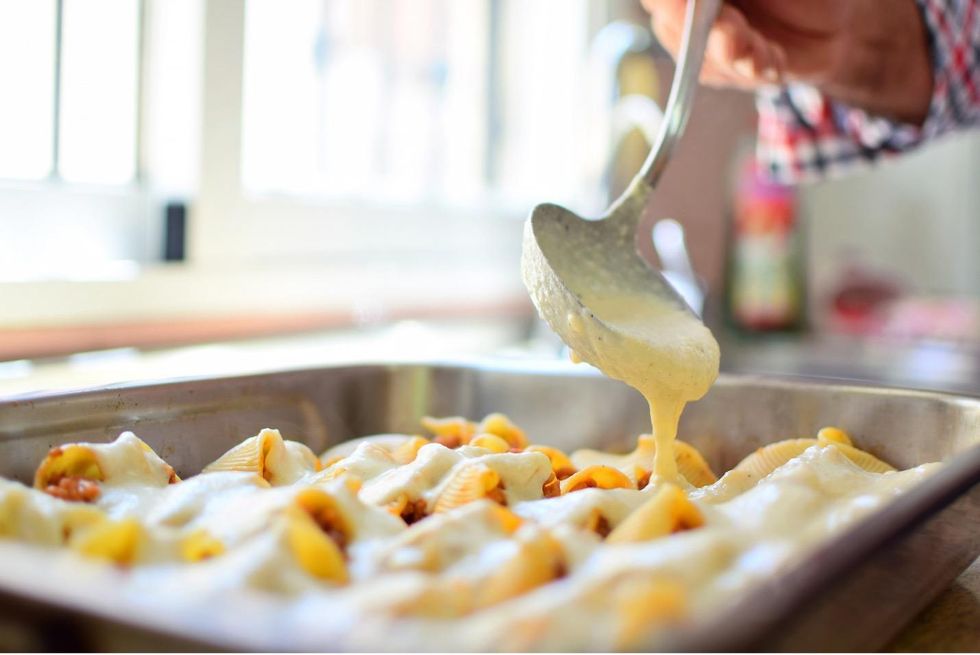The 5 plant-based Ramadan recipes to try today
There are plenty of delicious plant-based Ramadan recipes that even the biggest meat-lovers will undoubtedly enjoy.

Koshari
World Animal Protection has moved the world to protect animals for more than 55 years. World Animal Protection works to give animals a better life. The organization's activities include working with companies to ensure high standards of welfare for the animals in their care; working with governments and other stakeholders to prevent wild animals being cruelly traded, trapped or killed; and saving the lives of animals and the livelihoods of the people who depend on them in disaster situations.
World Animal Protection influences decision-makers to put animal welfare on the global agenda and inspires people to change animals' lives for the better. More information on World Animal Protection can be found at: http://www.worldanimalprotection.us/
Written by Joe Loria, Meat Reduction Campaign Manager, World Animal Protection, US.
For those who eat little or no meat, dairy, and eggs, avoiding the animal protein-heavy dishes during Ramadan can be difficult. However, there are plenty of delicious plant-based Ramadan recipes that even the biggest meat-lovers will undoubtedly enjoy.
Ramadan is the ninth month of the Islamic calendar, observed by Muslims worldwide as a month of prayer, self-reflection, fasting, devotion to worship, and helping those less fortunate. Ramadan is celebrated all over the world, and as such, the traditions and meals vary drastically by region. We've included recipes commonly eaten by one of our Egyptian World Animal Protection staffers.
This year, Ramadan begins on April 12 and will last until May 12. For those who eat little or no meat, dairy, and eggs, avoiding the animal protein-heavy dishes during Ramadan can be difficult. However, there are plenty of delicious plant-based Ramadan recipes that even the biggest meat-lovers will undoubtedly enjoy. Here are some of our favorite plant-based recipes, for suhoor and iftar. Ramadan Mubarak!
Koshari - this is the Egyptian national dish

Sauce:
- 2 tbsp tomato paste
- 15 oz tomato sauce
- 1 cup of water
- 1 tsp cumin
- 1 tsp ground coriander
- ½ an onion
- Optional: 1 Green pepper
Fried Shallots:
- 1 cup of vegetable oil
- 2 shallots
Rice and Pasta:
- 1 cup of medium grain rice (sushi rice is perfect here)
- ¾ cup of brown lentils
- 4 cups of water
- Pinch of salt
- 1 cup of elbow pasta
- Optional: canned chickpeas
For the sauce, roast the green pepper in the oven for 40 minutes until tender. Remove seeds and green pepper top and puree. Over medium heat, sauté diced onion until translucent. Add tomato paste, coriander, and cumin and cook for roughly 2-3 minutes to cook off the metal flavor of the tomato paste. Add puree tomato sauce and pureed green pepper. Simmer on medium-low for 30 minutes, stirring occasionally. Season with salt and pepper to taste.
For the fried shallots, thinly slice the shallots into rings. Try to be as consistent as possible, so the shallots cook evenly. In a saucepan add the shallots and cold vegetable oil. The shallots should be fully submerged, so they fry instead of sauteing. Cook over medium heat for roughly five minutes agitating the shallots slightly so they don't stick together and cook evenly. Don't walk away while doing this because the shallots can urn very easily. Once golden brown, remove from the oil and salt. Remember, the shallots will continue to cook once you remove them from the oil, so remove them when they are still on the pale side.
Rice, add the rice and lentils to pot, and rinse a few times under cold water to remove any excess starch off the rice. Add water and a pinch of salt. Cook on medium heat for 20 minutes or until the rice and lentils are fully cooked.
For the pasta, follow box instructions.
Assembly, In a bowl or plate, combine rice and lentils, pasta, chickpeas, add a layer of tomato sauce, and top with a handful of fried shallots. Enjoy!
Macarona bel béchamel (macaroni with béchamel)

Bechamel:
- 1 ½ cups of Earth Balance butter
- 3 cups of plant-based milk (I use Oatly)
- 1 cup of flour
- ¼ cup of all purpose flour
- 1 tsp nutmeg
Impossible beef:
- 1 package of ground beef alternative (Impossible or Beyond beef)
- 1 tsp of cinnamon
- 1 tsp of Allspice
- 2 tbsp of neutral oil
Pasta and tomato sauce:
- 1 package of rigatoni
- 1 can of tomato paste
- 1cup of pasta water
For the bechamel, melt the butter in a saucepan, once it's all melted, add the flour stirring constantly and cook for one to two minutes until the flour looks a little toasty. Add in the plant-based milk gradually and whisk constantly until all the milk is incorporated and you have a smooth creamy texture that coats the back of a spoon.
For the plant-based beef, heat the oil in a skillet over medium heat. Once the oil is heated, add the beef, cinnamon, and Allspice. Cook until the beef is browned, and fully cooked through. Off the heat, add ¼ cup of béchamel to the mixture and stir to incorporate. Set to the side.
For the pasta, follow the box instructions to make al dente pasta and subtract two minutes from the cooking time. You don't want the pasta to be fully cooked through since it will bake for a long time in the oven.
For the sauce, in a skillet, over medium heat, add the tomato paste and cook for about two minutes – the goal is to cook off any metal or raw taste in the paste. Add pasta water to the skillet and bring to a boil. Cook until the sauce has thickened to the texture of a traditional pasta sauce. Off the heat, add ¼ cup of the béchamel and the cooked pasta and mix until all the pasta is coated in the sauce.
Assembly, in a baking dish, add a thin layer of the béchamel to coat the bottom. This will prevent the bottom from sticking to the pan. Add all the pasta to the bottom of the pan. Add the beef mixture atop the pasta. Layer the bechamel sauce over the mixture, it should be a thick layer. Bake for 20 minutes at 350 degrees. As an optional step, place under the broiler for five minutes to brown the top of béchamel.
Let rest for 10-15 minutes and serve hot.
Eggplant with pomegranate reduction

- 1 large eggplant cut into small cubes
- 1 cup of spinach
- ½ can of crushed tomatoes
- 1 medium onion chopped
- 1 garlic clove minced
- 1 tablespoon of sumac
- 3 tablespoons of pomegranate molasses
- ¾ cup of olive oil
Generously salt eggplant for 30 minutes prior to cooking. In addition to seasoning the eggplant, this will draw out excess moisture from the eggplant.
Add olive oil to a skillet or cast iron on medium-high heat. Once the oil is heated, start browning eggplant in batches, brown the eggplant on all sides for roughly 4-5 minutes for each batch. Remove eggplant from skillet and set aside.
Add more olive oil to the skillet and cook onions until translucent. Add garlic and cook for 1 minute.
Mix in crushed tomatoes, pomegranate molasses, and sumac and bring to a boil then lower heat to medium-low. Simmer on low for 10 minutes stirring occasionally until a reduction is formed (the sauce should coat the back of a spoon).
Once desired consistency is achieved, add eggplant and spinach to the pan and cook for two minutes.
Plate over rice and enjoy!
Kofta

- 1 package of ground beef alternative (Impossible or Beyond beef)
- 1 tsp of garlic powder
- 1 tsp of onion powder
- 2 tsp of Allspice
- 1 tsp of Cinnamon
- ¼ cup of oat milk
- ½ cup of panko
- ¼ cup of chopped parsley
- 4 pinches of salt
Mix all the ingredients thoroughly in a bowl. To test the seasoning, you can take a small portion of the mixture and cook in a skillet for 1-minute.
Separate the mixture and begin forming into meatballs or a 2-inch-long oblong shape. Heat a skillet over medium heat, add a thin layer of olive oil and cook the kofta in batches. It should take 3-4 minutes per side each side should be browned.
Kofta pairs well with any tomato-based dishes or the Eggplant dish listed above.
Baba ghanoush

- 2 medium eggplants
- 2 cloves of garlic
- ¼ cup of tahini
- ¼ cup of olive oil
- ¼ cup of lemon juice
- Salt to taste
- Optional: a pinch of paprika
Preheat oven to 400 degrees.
Cut the eggplant in half length-wise, place in a sheet tray, and toss in a thin coat of olive oil. Add salt and pepper. Cook for about 30 minutes or until fork-tender. Let the eggplant cool for 10-15 minutes until cooled slightly and remove the eggplant skin. Toss the eggplant skin.
Add the eggplant into a blender or food processer and add the rest of the ingredients. Blend until smooth and season to taste.
---
Now that you know some of your favorite Ramadan meals can be made plant-based, try them out!
Looking to #EatLessMeat? We'll help you get started when you join Meating Halfway, a 21-day journey that'll guide you towards eating less meat!


